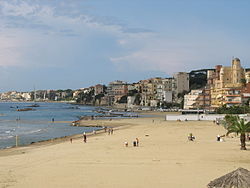Nettuno
Nettuno | |
|---|---|
| Città di Nettuno | |
 Panorama of Nettuno | |
| Country | Italy |
| Region | Lazio |
| Province | Rome |
| Frazioni | Acciarella, Cadolino, Canala, Cioccati, Cretarossa, Eschieto, Falasche Nord, Grugnole, Ospedaletto, Padiglione, Piscina Cardillo, Pocacqua, Sandalo Di Levante, Sandalo di Ponente, San Giacomo, Scacciapensieri, Tre Cancelli, Zucchetti |
| Government | |
| • Mayor | Alessio Chiavetta |
| Area | |
| • Total | 71.46 km2 (27.59 sq mi) |
| Elevation | 11 m (36 ft) |
| Population (30 April 2009)[2] | |
| • Total | 46,349 |
| • Density | 650/km2 (1,700/sq mi) |
| Demonym | Nettunesi |
| Time zone | UTC+1 (CET) |
| • Summer (DST) | UTC+2 (CEST) |
| Postal code | 00048 |
| Dialing code | 06 |
| Patron saint | Madonna delle Grazie |
| Website | Official website |
Nettuno is a town and comune of the province of Rome in the Lazio region of central Italy, 60 kilometres (37 miles) south of Rome. A resort city and agricultural center on the Tyrrhenian Sea, in the Mediterranean Sea it has a population of approximately 46,000.
Name
It is perhaps named in honour of the Roman god Neptune.
Economy
It has a touristic harbour hosting about 860 boats and a shopping center,selling everything for fishing and sailing. There is also an extensive yacht club.
Nettuno is the city of the D.O.C. wine Cacchione.
Nettuno has one of the biggest bases for the Italian Force, whose territory extends to the Province of Latina, and one of the most important Italian Police Schools, where especially police dogs are trained.
Nettuno is one stop south of Anzio on the local train from Rome.
History
According to a theory, the town is a direct survival of the roman Antium, which territory in the roman era almost entirely corresponded to modern Nettuno and nearby Anzio.[3] It is a popular tourist destination today, where there are a well-preserved old quarter, the Borgo Medievale, with mediaeval streets and small squares, and the Forte Sangallo, a castle built in 1503 by renaissance architect Antonio Da Sangallo Il Vecchio (Antonio da Sangallo the Elder).
It is an important center of pilgrimage to the shrine of Saint Maria Goretti. In the shrine there is a crypt where lie the mortal remains of the saint. The church keeps also a priceless polychromed wooden statue of Our Lady of Grace, which is honoured by the town with a procession every year the first Saturday of May. It was originally Our Lady of Ipswich, although it left England after the Reformation.
The privately owned Villa Costaguti-Borghese at Nettuno, built 1648, has extensive gardens in a landscape park designed about 1840, now protected as a nature reserve. The Borghese Gladiator was discovered at Nettuno.
Nettuno Baseball Club is one of the most important Italian baseball teams, often winner of the national championship. Baseball was taught to the local people during the Second World War by American soldiers, who landed along the coasts.
Indeed, Nettuno and nearby Anzio were the theatre of an Allied forces landing and the ensuing Anzio-Nettuno battle during World War II: the Operation Shingle.[4] American forces (5th Army) were surrounded by Germans in the caves of Pozzoli in February 1944 for a week, suffering heavy casualties. A movie based on the events called Anzio (1968, directed by Edward Dmytryk) was made, starring Robert Mitchum and based on a book by Wynford Vaughan-Thomas.
At the north edge of town is the Sicily-Rome American Cemetery and Memorial, where over 7,800 U.S. soldiers are buried.[5]
A key feature of Nettuno is the "fort" - a medieval wall which goes around an entire neighborhood of stone-paved streets.
In the late 1980s, Nettuno figured prominently as a transit point for Jewish immigrants on their way to Israel or the United States. Since the Soviet Union and Israel did not have diplomatic relations, Italy agreed to serve as a staging ground for Jewish refugees to Israel from the Soviet Union. Upon entering Italy, refugees would file a petition with the Israeli consulate and await approval. Many Jews took advantage of this opportunity to petition the U.S. consulate for asylum to let them enter the United States on religious persecution grounds. Though the majority of Russian Jews settled in Rome and Ladispoli (a small city near Rome), a significant number of them, particularly those from the Ukrainian city of Odessa, chose Nettuno as their temporary home, perhaps due to its magnificent beaches and lively night scene. Other, much more insignificant Italian cities such as Santa Marinella also served as temporary homes, though they offered little beyond "Wheels of Immigration" - a pretzel-like snack as comfort to their visitors.
Notable residents
- The famous Italian actress Anna Favella is from Nettuno.
- birthplace of Italian soccer legend Bruno Conti.
- Maria Goretti
- Paolo Segneri
- Emiliano Conti (born 30 November 1985 in Velletri, province of Rome) Midfielder of Roma Leones Lacrosse
Twin towns
 Ardee, Ireland
Ardee, Ireland Corinaldo, Italy
Corinaldo, Italy Traunreut, Germany
Traunreut, Germany Bandol, France
Bandol, France Wehr[disambiguation needed], Germany
Wehr[disambiguation needed], Germany
References
- ^ "Superficie di Comuni Province e Regioni italiane al 9 ottobre 2011". Italian National Institute of Statistics. Retrieved 16 March 2019.
- ^ "Popolazione Residente al 1° Gennaio 2018". Italian National Institute of Statistics. Retrieved 16 March 2019.
- ^ Paola Brandizzi Vittucci, Antium: Anzio e Nettuno in epoca romana, Roma, Bardi Editore, 2000. ISBN 88-85699-83-9
- ^ Pietro Cappellari, Lo sbarco di Nettunia e la battaglia per Roma 22 gennaio - 4 giugno 1944, Herald Heditore, Roma 2010
- ^ SICILY-ROME AMERICAN CEMETERY AND MEMORIAL, http://www.abmc.gov. Accessed 2009-05-25.
External links

